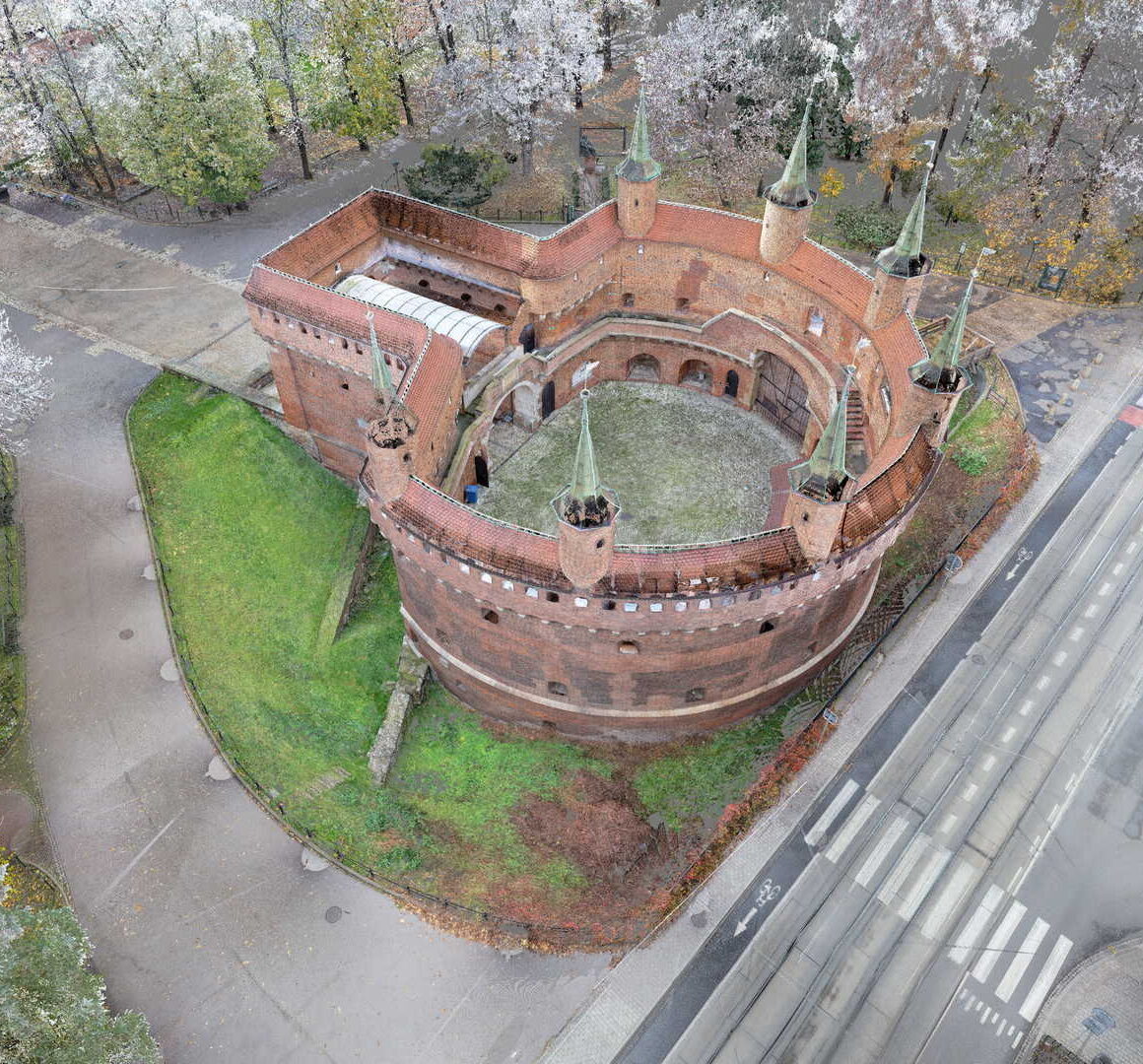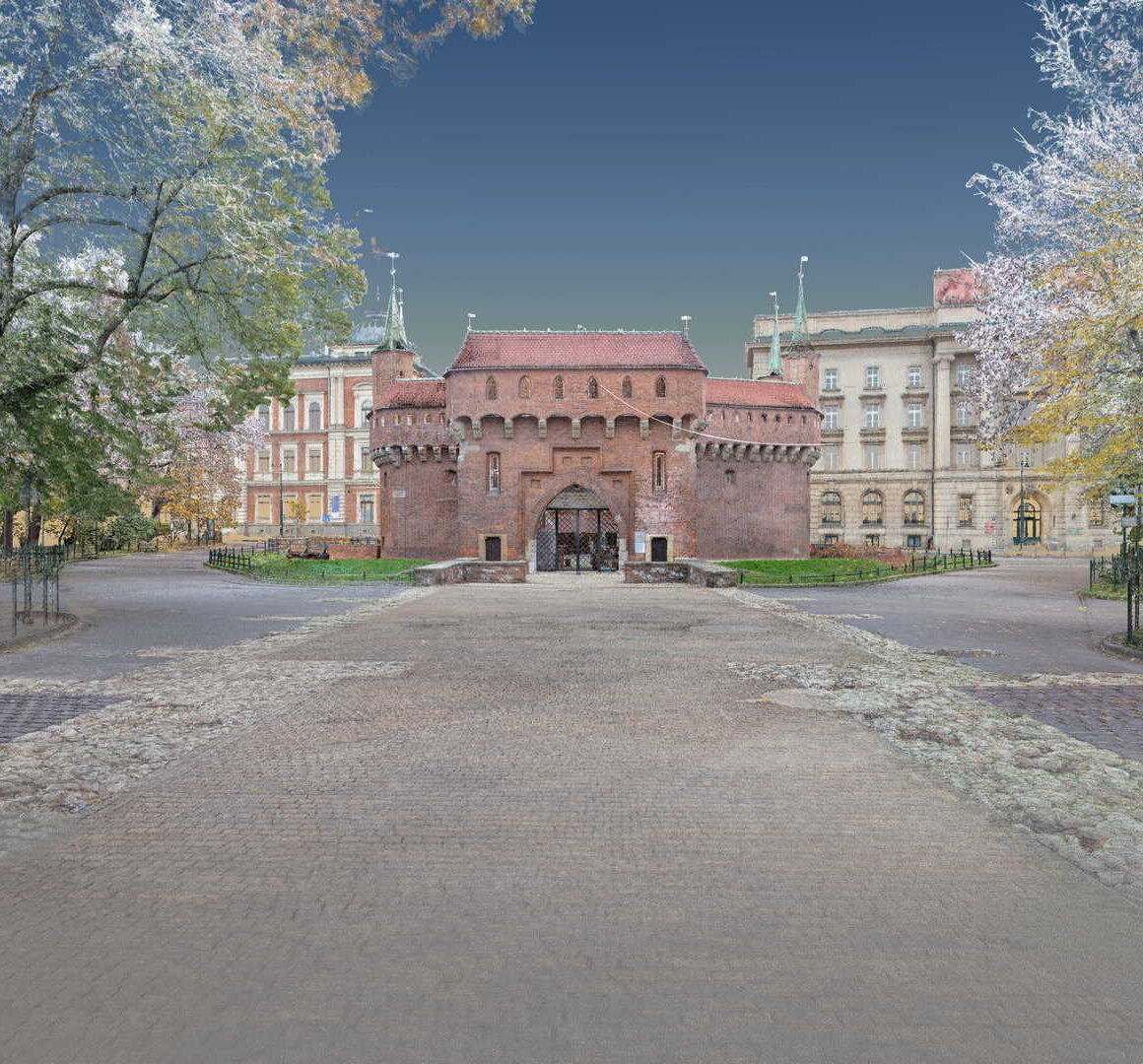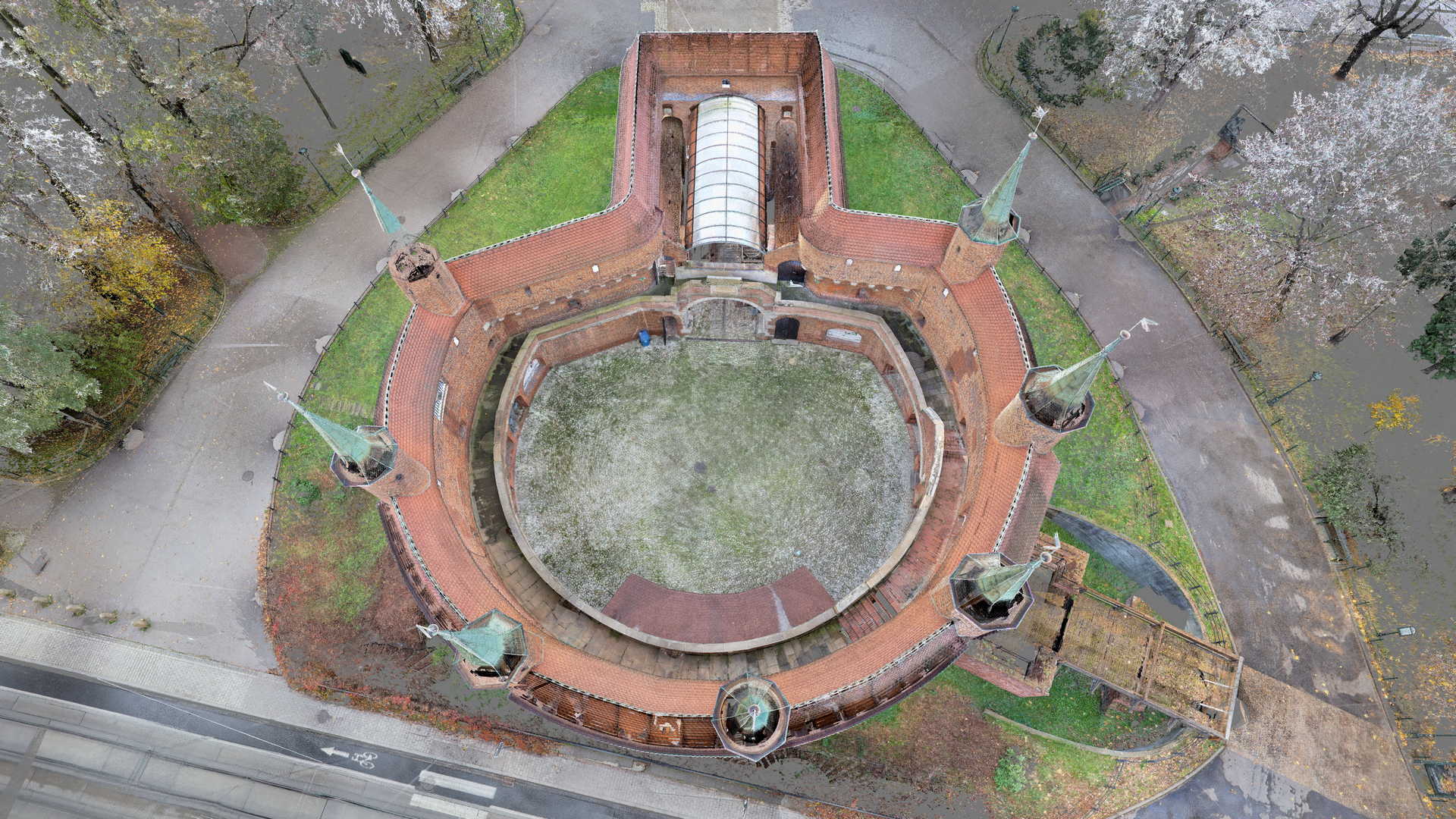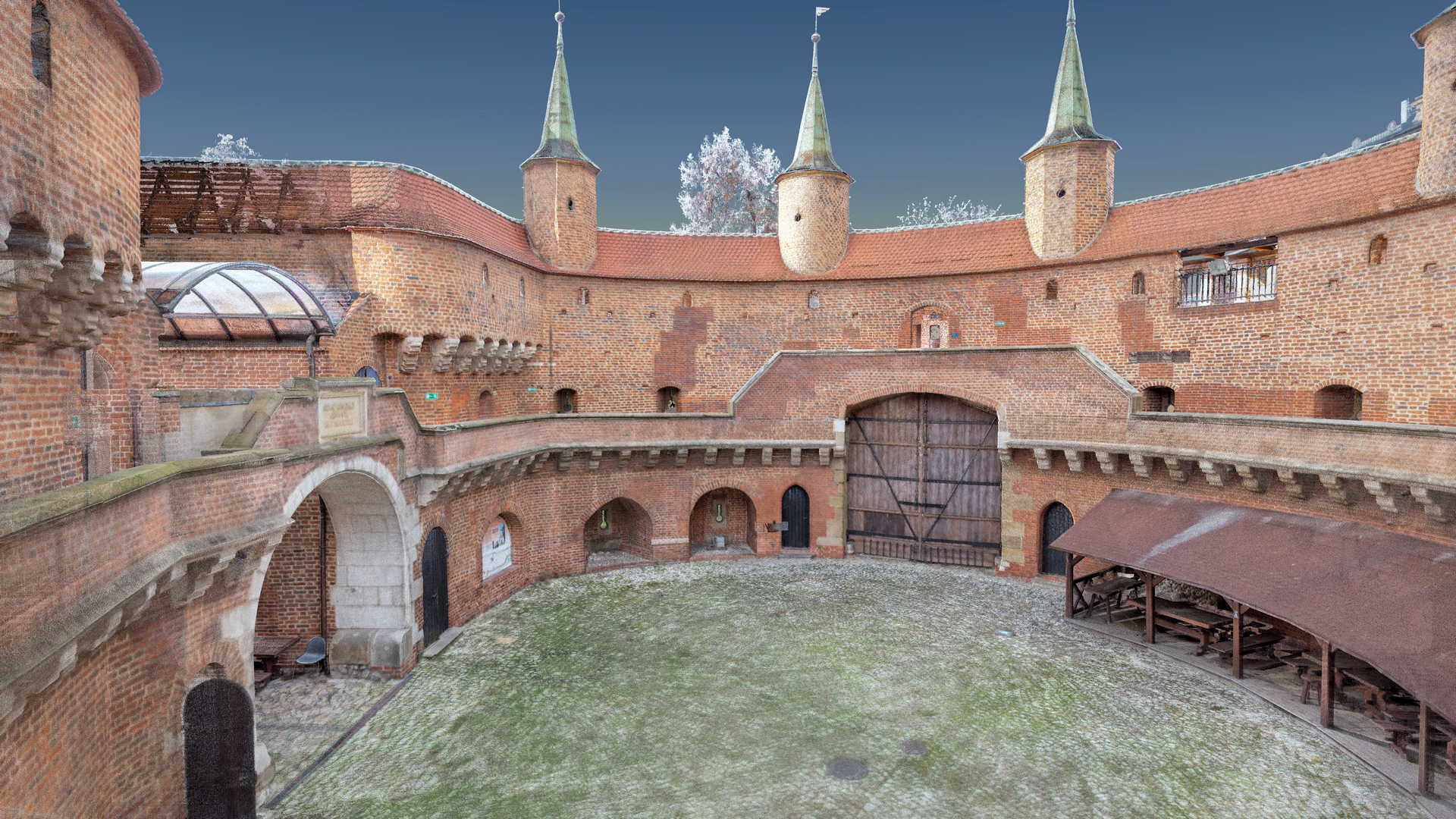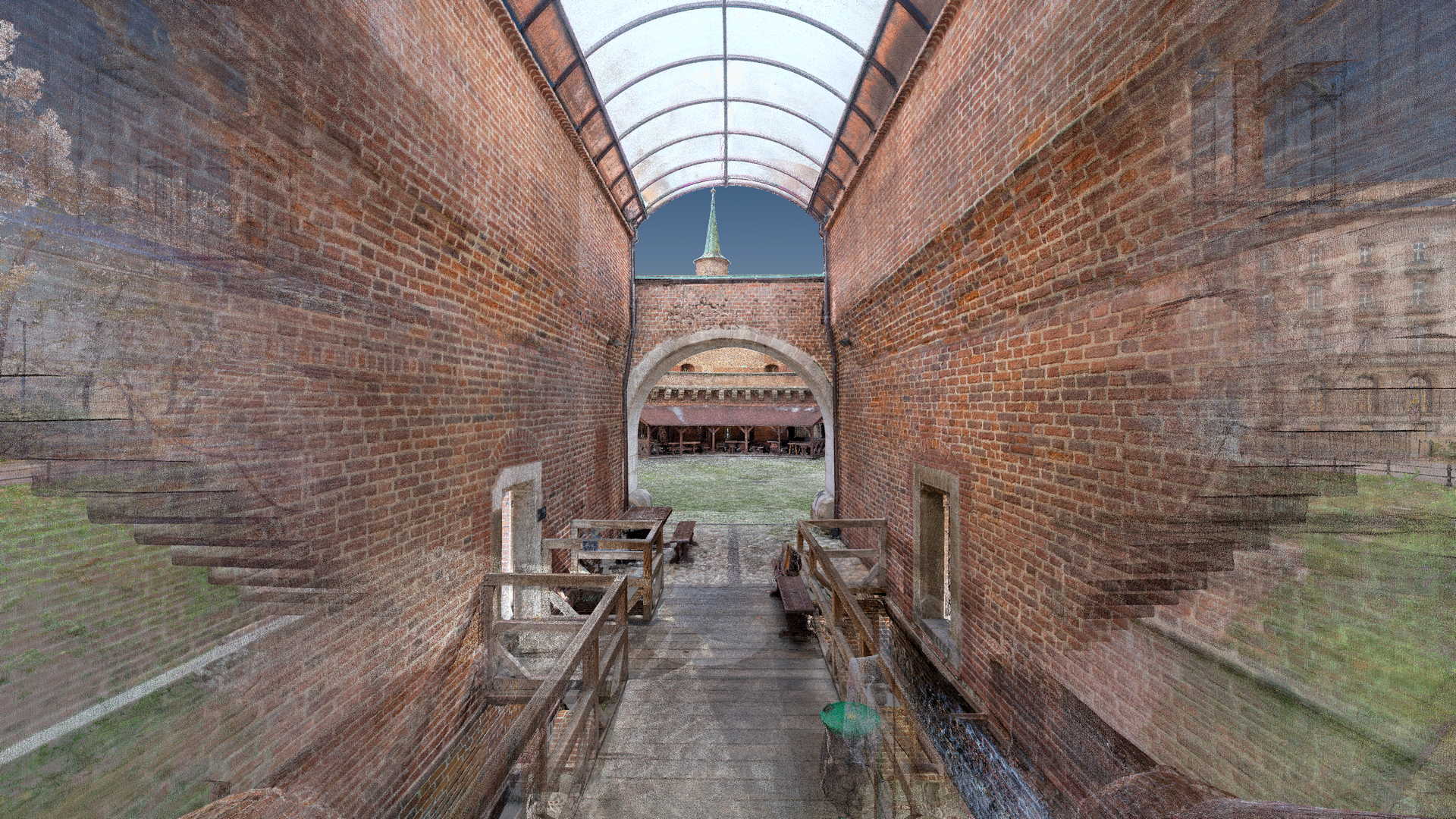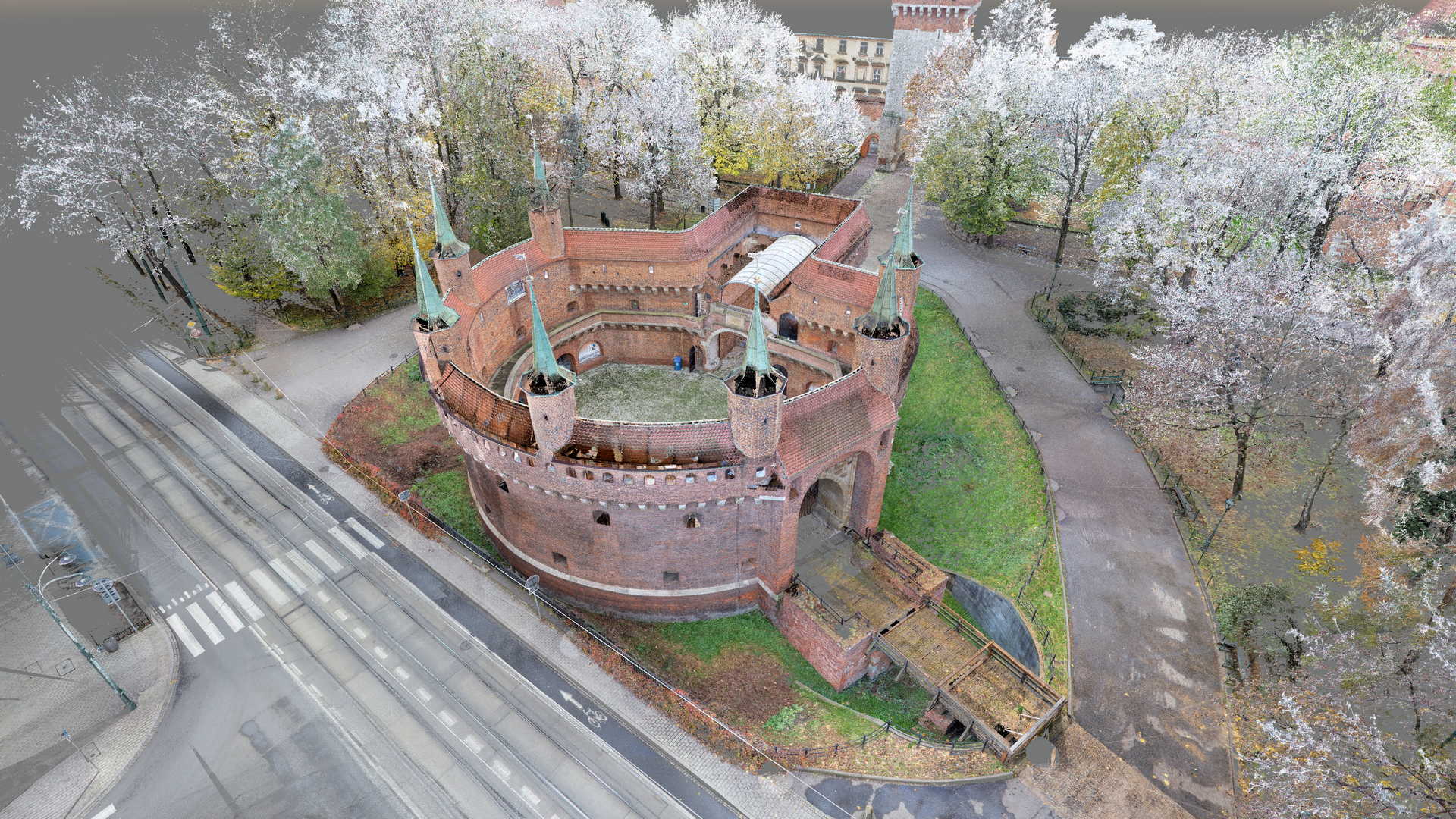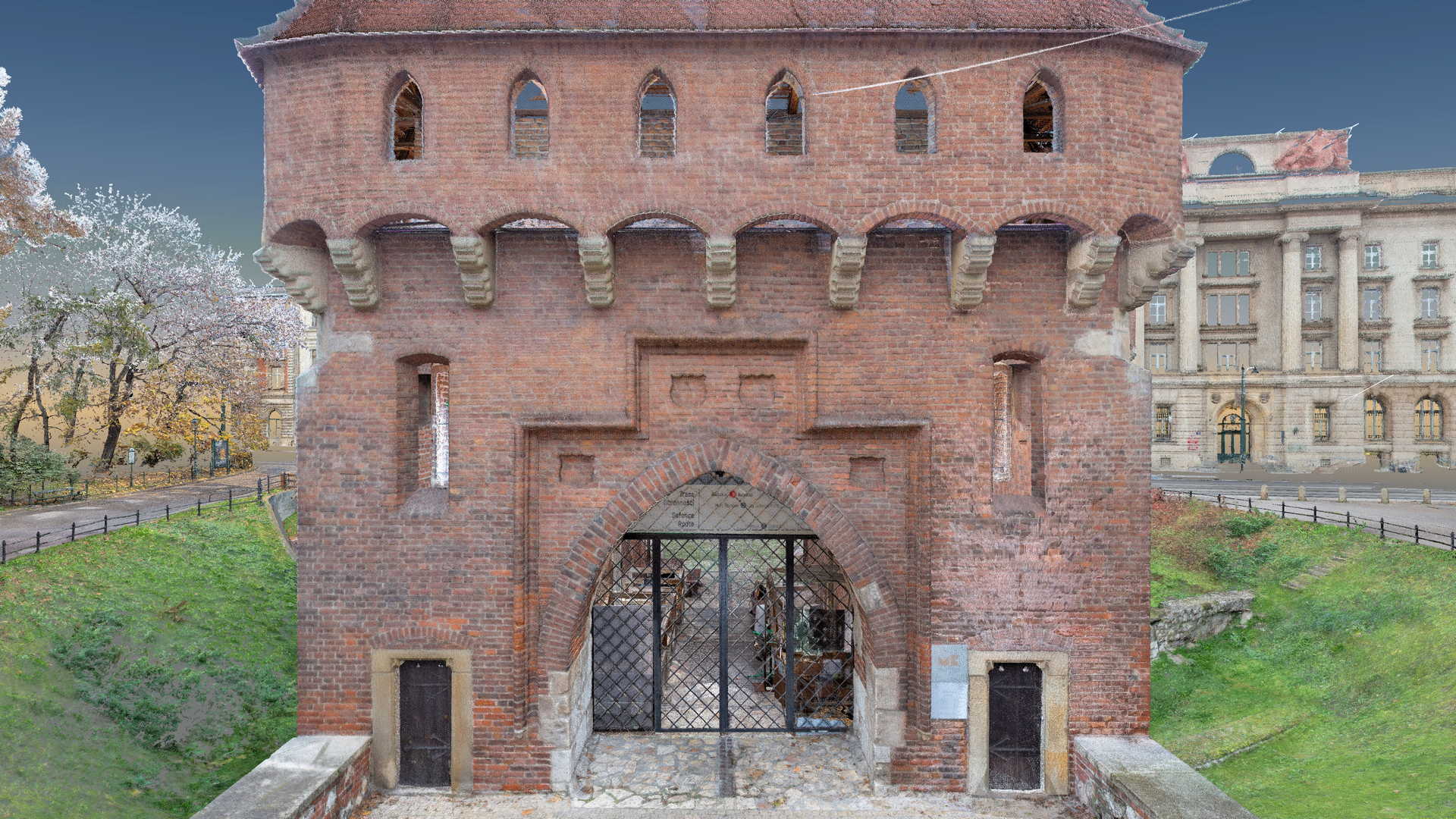Kraków Barbican
The beginning of the 15th century saw a breakthrough in defensive construction, mainly due to the appearance of weapons using black powder. Improvements to defensive structures in the form of fortifications were aimed at counteracting the effects of firearms. First of all, due to the range of the new weapons, efforts were made to extend the fortifications to the fore field as much as possible, which would prevent the attackers from digging trenches with mines under walls and fortified towers. For this purpose, new lines of walls were built, new moats were dug, the existing ones were widened, the walls were raised, and the number of positions for defenders, such as arrowslits, was doubled to increase the firepower. At that stage, apart from the still imperfect and expensive firearms, earlier types of weapons, as well as traditional attack and defense techniques, were still in common use.
Gradually, the walls were thickened and they were given a round, semicircular shape which provided better protection against bullets, and earth embankments were built in front of the moats, which protected the main wall from bullets with a flat trajectory. Wooden hoardings that were easy to set on fire started to be replaced by stone machicolations. As for permanent fortifications, similar efforts were made to focus on effective protection of the entrance gates, which led to the expansion of the so-called gatehouse. There is no doubt that barbicans were one of the most perfect forms of fortification that could stop the enemy at the city gates.
Fun fact: pre-firearms artillery
pre-firearms artillery, or ballistic devices used in ancient times and the Middle Ages, until the invention of firearms. These types of machines are divided into two types: neuroballistic machines (ballista, onager) using the relaxation energy of elastic materials, and baroballistic machines (bricola, trebuchet) which use the potential energy of the weight dropped from a height. These slowly disappeared after the invention of gunpowder, but were sporadically used as improvised weapons, e.g. during the Warsaw Uprising, bottles with gasoline were thrown using catapults made of springs.
Barbicans around the world
Barbicans started appearing in Europe in the High Middle Ages, which was most likely the result of the development of European defensive architecture after its contact with the East during the Crusades. Many researchers believe that the first barbicans were built in strongholds in Central Asia and then continued their “journey” via Persia to the Middle East, where the architectural form was encountered by Europeans fighting to reclaim the Holy Land from the hands of Muslims. The very name of this type of fortification is probably derived from the Arabic b-al-baqara, “barn gate” or Persian balahana, “high house”, but the origin of the name remains uncertain to this day.
In Poland, documents from the times of Alexander Jagiellon use the name arx, as well as the colloquial term rondel (“saucepan”) – due to the usually circular shape of this type of building in our lands. The name “barbican” does not appear in Poland until the 19th century. Many barbicans in Europe have survived to our times, including those in Lübeck, Carcassonne, Zgorzelec, Gdańsk, Drogheda, and of course Kraków. For geographic reasons, individual barbicans differed from each other – those from the south of Europe are usually circular, while in the north of the continent – rectangular or polygonal with a moat around. The Kraków Barbican is a combination of those two forms. The concept of barbicans was later developed by the entrance gates in cities and fortresses led by the so-called ravelins.
Kraków Barbican – history
The history of the building, which now is a symbol of Kraków and one of the most characteristic landmarks, is inextricably linked with King John I Albert. This extremely interesting ruler grew up at the turn of the Late Middle Ages and the Renaissance period which was on its way from Italy to Poland. His two most important and distinguished teachers were Jan Długosz (Johannes Longinus) and Filip Kallimmach, the first representing the passing Middle Ages, and the latter – the nascent Renaissance. John I Albert even became friends with Filip Kallimmach, which resulted in their joint night-time escapades outside the walls of Wawel so they could indulge in excessive drinking and partying.
John I Albert combined his love for junkets with exceptional military talents. When, on the orders of his father Casimir IV Jagiellon, he served as governor of Ruthenia in 1486-1490, he became famous for defeating the Tatars at the Battle of Kopystrzyń in 1487, which provides a very good assessment of his military talents. He also started creating the so-called common defense that was said to defeat the Tatar and Turkish invasions on the south-eastern borderlands. However, despite his incredible military talent, the ruler is remembered mainly for one defeat and the saying “Za króla Olbrachta wyginęła szlachta” (“King Albert was the reason for the nobility’s death”). It was already under the rule of his father, Casimir IV Jagiellon, when the Polish-Turkish conflict in Moldavia began. It was over the two port cities of Kiliya and Bilhorod defending the borders of Polish and Lithuanian-Ruthenian lands from the east, as well as providing trade routes to the east and the flourishing Polish cities in the east, such as Lviv. There was also the issue of the Moldavian throne being seized by a hospodar favoring Poland, as well as avenging the defeat in the battle of Varna where King Władysław II had died. The war was the favored option not only due to the interests of the state but also of the Jagiellonian dynasty – there were plans to appoint Duke Sigismund, the future King Sigismund I the Old, as a Moldavian hospodar. In 1497, an army of 40,000 led by King Albert entered Moldavia. Despite being a Polish vassal, Stephen the Great, who ruled there at that time, sided with the Turks.
The siege of the capital Suceava failed, and when the troops were returning to the country through the Bukovina forests near Koźmin, the Turks, Tatars and Moldavians ambushed the Polish army and killed about 5,000 knights. In addition to the well-known saying about the extinction of the nobility, the defeat resulted in a renewed threat from the Teutonic Knights, which led to the king, who was making new army recruits after the defeat in the south, ending up in Toruń. The city built and fortified by the Teutonic Knights, who had fought Muslims in the Holy Land, had as many as two barbicans. In the face of the approaching threat of an attack on Kraków by the Turks or Moldavians, this was what gave John I Albert the idea of building this type of fortification in his capital and, in 1498, he set the cornerstone for its construction and donated 100 grzywnas for this purpose. St. Florian’s Gate already had a gatehouse in the form of a tower, which was ended by a brick “neck” sometimes known as a “trip” – now this protruding section of the walls was to crown the barbican, forming the so-called “key work” of Krakow’s fortifications from the north. In 1498, a full-scale invasion of Moldavians, Tatars and Turks was carried out in the south of the country, reaching Przemyśl, in retaliation for the unsuccessful Bukovina expedition, further accelerating the construction of the Kraków Barbican, which was completed in 1499.
It seems, however, that such an important construction project carried out at such a fast pace must have required prior preparations – for example, measurements and collection of building materials, and perhaps the design of the Kraków Barbican had already started during the reign of Casimir IV Jagiellon. To this day, we do not know the name of the architect responsible for this characteristic building, he is only referred to as “the master of the Barbican”. However, he must have been a high-class architect, as evidenced by the fact that the Kraków Barbican is similar in its form to the Imola one which was designed by Leonardo da Vinci. The building designed by the master used some of the best solutions of defensive architecture of that time. He was undoubtedly both an outstanding engineer and an artist who was very familiar with European architecture. After the building was finished, its defense in the event of an invasion was entrusted to the guild of furriers, just like with St. Florian’s Gate.
Fun fact: “wycieczka” (“trip”)
Although today this word does not carry a military meaning for us, it used to mean the expedition of defenders beyond the walls, for example, to attack the besieging camp at night. In Kraków, it was also the name for the gate extensions used by the defenders to go on “trips” to the enemy camp.
Kraków Barbican – architecture
The architectural form of the Barbican is an outstanding example of a late Gothic structure. The fortress was built on the plan of a circle in the proportion of 6:10 with an internal diameter of 24.4 m and an external diameter of over 30 m. The lower part of the wall is thicker and measures 365 cm, the upper parts are 200-250 cm thick, and 150 cm at places. The foundations of the building were made of crushed limestone joined using a large amount of mortar at a depth of about 7-8 meters, the lower part of the wall was built of processed sandstone up to the water level in the moats; the higher parts of the wall, which protrude above the water level in the moat, are brick laid using the so-called “Polish” system. Apart from brick, some elements of the higher stories of the building were made of processed and carved limestone and sandstone, including arrowslits, gateway portals or machicolation elements. To this day, the top of the building is adorned with 7 alternating octagonal and round towers, covered with a copper roof (it used to be made of lead) for observation, and each of them is topped with a characteristic Gothic flag. Below, there were direct defensive machicolations covered with a saddle roof and equipped with bay windows to drop projectiles on the heads of the attackers. The walls hid 4 levels of walkways for defenders with 130 key-shaped loopholes arranged in checkerboards, typical for the use of firearms – light weapons in the upper parts and higher-caliber firearms below them, but without high-caliber artillery (deployed only on the city walls). The buildings were surrounded by a huge moat, 26 meters wide and 6 meters deep, which was fully regulated, its bottom lined with stones, which facilitated cleaning and prevented water from escaping or washing out the walls. From the outside, the moat was additionally surrounded by a stone and brick retaining wall with a 7-meter high earth embankment, attached to a dry moat, 3-4 meters wide and about 3 meters deep. The width of the Kraków Barbican, in relation to the neck, made it very similar to the later 16th-century Renaissance fortifications known as orillons. In the extension of the walls, stone bulkheads were built across the moat with culverts and locks that made it possible to adjust the water level and, if necessary, they provided a good shooting spot. They were accessible from the underground passageways, i.e. the so-called posterns, which also served as a passage for defenders – they allowed movement from the inside of the city fortifications to the fore field.
Thanks to its circular form, it was possible to shoot from the Barbican in every direction, mainly towards the two key northern routes, i.e. the Warsaw and Silesian routes, as well as the Kleparz market with its adjacent areas. In addition, the Barbican was a spot from where it was possible to hit the enemy from the flanks, if they stormed the walls, and to defend the moat. The only entrance to the Barbican led through the Kleparz Gate with two bridges – one of them being easy to dismantle or burn, supported on stone pillars, and the other one in the form of a drawbridge.
The Kleparz Gate was not situated on the same axis as the main northern St. Florian’s Gate, but 30 degrees west, in order to cover the only entrance to the stronghold in a more effective way. To get to the city, the enemy had to go through a total of 7 gates (including the Barbican, the neck, and St. Florian’s Gate), while coming under constant fire from defenders. In addition, the neck hid another wooden bridge with a trapdoor over the moat, and the defenders could safely move from St. Florian’s Gate to the Barbican through underground tunnels. Thanks to its internal galleries and arcades, the building could defend itself even if the enemy invaded the courtyard, and thanks to the extensive gates facing the city, it could effectively defend itself if the enemy took the city walls. The posterns and cellars of the fortress could store food and weapons for several years during a siege.
John I Albert’s successor, Alexander Jagiellon, in the privilege of September 30, 1505, wishing to proceed with the extension of city fortifications towards the north, gave councilors all the houses and squares located between St. Florian’s Church and the Barbican and St. Florian’s Gate. The idea was that the councilors would not allow any new buildings to be erected in that area, in order to make shooting from the stronghold easier, and so that the buildings could not serve as a shelter for the besiegers.
Other improvements to the Barbican’s defensive features were carried out in the 1750s, when it was surrounded by earth fortifications in the shape of a semicircular bulwark to better protect the buildings from the fire of increasingly accurate cannons. In the next period, i.e. the 18th century, there were no major changes in the Barbican and the entire defensive system of the city, the residents only made efforts to make temporary repairs of the fortifications, which were in an increasing state of disrepair with the passage of time.
From the 15th to the 17th century, the Kraków Barbican was considered unconquerable among the military, even despite the development of firearms and the wider use of earth fortifications against artillery. Since the construction of the building, no enemy dared to storm the city from the north. Even such experienced armies as the army of Archduke Maximilian Habsburg during the siege of 1587 or the brave and seasoned Swedish army during the Deluge preferred to avoid leading their main attacks from the side of this terrifying building. The enemy dared to attack the city from the side of the Barbican only once. In 1768, during the Bar Confederation, it was stormed by the Russians, without success. It was then that the Barbican scored its last triumph over the enemy forces trying to capture the city.
Fun fact: Firearms:
Weapons using the energy generated by black powder (or smokeless powder in later weapons) to throw projectiles. Depending on the design, they are divided into barrel firearms and rocket artillery. They appeared together with the invention of black powder in China in the 9th century. When they reached Europe, probably via the Mongols, they brought a paradigm shift in the conduct of war, such as the end of the era of cavalry superiority on the battlefield or a change in the way of building fortifications.
Barbican – south elevation
The representative function of the Barbican
As part of the most important gate to Kraków, the Barbican also served representative functions for centuries – it was the so-called Porta Glorie (the Glory Gate) and the start of the Kraków Via Regia. The impressive architectural form of the building, not devoid of decorations, additionally raised its representative value. As the Glory Gate, the Barbican has been a witness to many significant events in the history of the city and the country since its inception. The Barbican served as a passage for coronation parades, troops doing their victory marches, mourning and funeral parades after the death of rulers or other great Poles, and it was where the wedding processions of future Polish queens and grand foreign envoys entered Wawel. Those ceremonial parades took the form of national holidays aimed at creating a propaganda effect, while also being a kind of spectacle or performance. The coronation entries that accompanied Kraków as the capital after the introduction of the elective monarchy were some of the most impressive ones. First, the procession would stop at St. Florian’s Church in Kleparz, to then proceed to the Barbican, where city councilors and other notable townspeople were waiting in the courtyard, welcoming the new ruler on behalf of the city and its inhabitants. Then, the procession would continue via St. Florian’s Gate, through the Main Square next to St. Mary’s Church, Grodzka, Senacka and Kanonicza Streets to Wawel, where the coronation would take place in the Cathedral. The ceremonies accompanying the election of Henry III of France as the King of Poland saw the first such triumphal entry to the coronation. It was accompanied by a rich set design, and the residents of Kraków stretched a canopy over the king in the Barbican, which accompanied him to Wawel. The solemn procession was attended by about ten thousand people and was held at one in the morning with remarkable illumination. After that, efforts were made to make each coronation entry an artistic spectacle.
Another coronation entry worth mentioning was the one after the election of John III Sobieski, when the king saw a large painting in the Barbican, which depicted him at the time of defeating the Turkish army near Khotyn. Later, he went to Wawel under a canopy, accompanied by music and cannon salvos.
During the partitions, when there were no coronations or triumphs to celebrate, national heroes and bards became the main heroes of ceremonial parades through the Barbican. The Barbican lost its defensive function and became a symbol of national heritage and a historical memento that the city inhabitants felt close with during their struggle for independence. It was often a site of patriotic and political demonstrations related to the independence aspirations of Poles. One such ceremony involved bringing the body of Tadeusz Kościuszko to Kraków in 1818. What is more, it was the Barbican that Jan Styka saw as a place where he could place the Panorama of the Battle of Racławice at the beginning of the 20th century, but the proposal was not met with a positive response from the city authorities. The Barbican served as a venue for welcoming not only our historical heroes, but also the rulers of Austria-Hungary – Franz Joseph I in 1880, Charles I in 1917, as well as Ferdinand Foch, marshal of France, Great Britain and Poland, in the interwar period. During the celebration of the 500th anniversary of the Battle of Grunwald, the famous circus wagon of Michał Drzymała was displayed in the Barbican as a symbol of resistance to the Prussian invader. In June 1927, a coffin with the ashes of Juliusz Słowacki was kept in the Barbican before the solemn funeral at Wawel. In the interwar period, in addition to great national celebrations, the Barbican was also the site of events related to the city itself, including Kraków Days that were organized there from 1936, on the initiative of Jerzy Dobrzycki, as well as theater performances.
Barbican – north elevation
The Barbican saved from demolition – the restoration
The Deluge was followed by the gradual impoverishment of Kraków, which was made even worse by the later Great Northern War and the time of the partitions. All this affected the city’s finances, and thus its fortifications, which fell into disrepair. What is more, the Kraków fortifications no longer served their original function in the face of progress in warfare, while also being a problem during the expansion and modernization of the city. In 1802, the city authorities appointed by the Austrians issued a decision which included a provision to liquidate the ring of medieval fortifications. In 1804, Emperor Francis II issued the final decision to declare Kraków an open city and demolish the walls, but the actual demolition works were not carried out until 1806. Since the walls had lost their functionality, their dismantling, initiated by the occupiers, was continued by the authorities of the Duchy of Warsaw, and after the Congress of Vienna, the senate of the Free City of Kraków took the matter into its own hands – the city was then struggling with the problem of reorganizing the city’s urban planning, as well as some serious financial problems. One of the main problems with the former fortifications lay in the non-leveled debris and vacant buildings left after earlier uncoordinated wall demolitions. They disfigured the city and were at risk of collapsing, posing a threat to the lives of its inhabitants. Water and dirt accumulated in the remains of the moats, which posed a constant epidemic threat, and you could also get attacked among the ruins by the city’s criminal underworld. The leveling of the debris of the former walls began in 1817, together with the demolition of many remaining elements of the defensive system, unfortunately including those of high historic value. Demolitions intensified until the beginning of 1831, and in the following years the process slowed down. The works ordered by the Senate were often accompanied by the demolition of the walls to obtain building materials. During the works, one could also find some artifacts such as silver and gold coins, which provided an additional source of income. The city authorities tried to use the acquired materials on an ongoing basis to save money for new investments, such as canals, roads, and buildings, or for the renovation of existing buildings. There were plans to dismantle the Grodzka Gate, St. Florian’s Gate, and the Barbican to use the material for the Stradomski and Zwierzyniecki bridges and for new roads. The Grodzka Gate was completely destroyed, but senator Feliks Radwański, and in later years Jan Librowski, stood in defense of the characteristic northern fortifications. Adam Kazimierz Czartoryski was another defender of the preserved part of Krakow’s city fortifications. Slowly, voices about the need to preserve historic buildings in Kraków as historical monuments were heard more and more clearly.
Thanks to Radwański’s objection, the Senate meeting on January 2, 1817 agreed to slightly postpone the demolition. In his speech, Radwański appealed mainly to patriotic feelings, independence sentiments, and the times of Poland’s glory, including the times of Casimir III the Great.
He emphasized the fact that senators are Poles, so they should try to preserve the national heritage and respect the triumphant gate of Kraków and Poland, associated with some of Poland’s greatest historical figures. Radwański also cited the example of ancient buildings preserved around the world. He compared the Barbican to the Roman Colosseum, he gave the example of the Egyptian pyramids, Palmyra and Baalbek monuments, which had been preserved for posterity. Further arguments presented by Radwański to the Senate were of a more practical nature, related to hygiene and climate issues. This is where we reach the famous fragment of Radwański’s speech on the “bad northern winds” that will burst into the city carrying snow and diseases that are particularly dangerous for women and children: […] for the sake of health of pampered women and children, who would be exposed to frequent afflictions, like rheumatism and perhaps paralysis […]. His contemporaries commented humorously that Radwański had propped up the collapsing walls with the wind. He also raised aesthetic issues before the Senate, because the view from the north of the city at that time was not in line with the monuments of Kraków – the area around the Kleparz Market Square was full of neglected wooden sheds and stalls, garbage, vegetable scraps or slaughterhouse waste.
Despite several subsequent attempts to raise the issue of the demolition of the Barbican and St. Florian’s Gate, they were not successful, mainly due to the above-mentioned speech made by Feliks Radwański and the public interest in past times that he had awoken through his activities. After the meeting, the Senate made two cost estimates – for the demolition and restoration of this section of the walls, but the authorities and residents were already convinced of the historical significance of those buildings and the need to leave them. 1824 saw another attempt to demolish the Barbican, this time by the Economic Committee, which was blocked by the Senate that raised the issue of using the building in a practical way. In 1826, the inhabitants of the Kraków 4th and 5th communes filed a petition to demolish the relics of St. Florian’s stronghold. Radwanski had already died, so it was Jan Librowski who came to the defense of the fortifications. A year later, the Economic Committee, despite its earlier demolition plans, called for the restoration of the buildings. At the beginning of the 1830s, a fragment of St. Florian’s walls, together with the Barbican without a “neck” was the only remaining element of the former walls of Kraków, which was only further deteriorating. In 1826, there was also an idea to transform the Barbican into an entertainment venue, which was put forward by the son of Feliks Radwański, together with the outstanding architect Piotr Aigner. The only traces of this unrealized project are the sketches kept in the Radwański collection – they show the Barbican with a dome over the courtyard.
Barbican – eastern elevation
Finally, in 1834, the works to renovate the defensive complex of St. Florian’s Gate started, but the Barbican was only included in the restoration plans in 1841, and then it was due to public pressure. The restoration was to be carried out by Karol Roman Kremer who is the person responsible for the current form of the Barbican, transformed by him from a fortress into a more monumental building, blending into the greenery of the Planty Park that was being laid out at that time. The architect added the ogival entrance gate topped with a hoarding. Window openings were enlarged, and porch entrances were added. The builders used original stone and brick from previous reconstructions and demolitions.
Kremer left the moat. The turrets and the upper porch were covered with new timber roof trusses and tiles. Despite the changes, the Barbican retained much of its original form, mainly thanks to Kremer’s careful study of Gothic architecture. It should be noted, however, that the building was also damaged during the reconstruction, which was noted by Karol Kremer’s brother, Józef, in his 1870 conservation expert’s opinion. The Barbican was transformed from a military building into a romantic monument of the old days, which attracted some criticism from conservators opposed to Karol Kremer’s activities.

Barbican – western elevation
The Barbican was built as a military construction. It currently serves as a representation of the olden days. It is one of the most interesting and beautiful elements of the Kraków Old Town. The Barbican was built in 1498-1499, following the design of an excellent, but unknown architect. Until the 18th century, the building underwent numerous reconstructions. Then the Barbican gradually deteriorated. In the 1840s, Karol Kremer managed the renovation works with the current shape of the monument being their result. The Barbican is an example of late Gothic architecture. Its foundations are made of limestone and sandstone. The lower part of the wall, hidden underground, is made of sandstone. The visible parts of the walls are made of brick with sandstone elements. Their top is covered with a brick-tiled gable roof. The dominating color of the building is dark red i.e. the color of bricks.
The Barbican consists of thick walls built on an almost circular plan. They are twelve meters high. The building has two gates: the south gate and Kleparz Gate. In front of the south gate facing Floriańska Street, there is an eleven-meter long corridor. Its walls are made of brick. It is currently covered with a modern semi-circular glass roof. The corridor is called a gorge. It leads into a wall with a huge pointed-arched gate closed by an iron grille.
The other gate is called Kleparz Gate. As the name suggests, it faces the Kleparz neighborhood, i.e. the west. When we stand inside the Barbican, with our backs to the south gate and the gorge, Kleparz Gate is closer to the left side. It is closed by almost six-meter high wooden doors.
The walls surround an open courtyard. Its internal diameter is almost twenty-four and a half meters. The outer diameter of the Barbican walls is more than thirty meters. Their thickness in the lower parts is over three and a half meters, and in the upper parts – two and a half meters. The Barbican walls are circular in sixty percent of its circumference. The sections on both sides of the south gate are straight. The left section is about six and a half meters long and the right section is nearly ten meters long.
The walls are crowned with seven observation towers. They are located every few meters in the circular part of the Barbican walls, with round towers alternating with octagonal ones. They are covered with pointed copper roofs decorated with tin flags. The copper has turned green. The walls hide narrow corridors. The entrance to them is located to the left of the south gate. A winding staircase goes up a few meters, leading to a narrow corridor. It overlooks a porch surrounding the walls from the courtyard at a height of almost seven meters.
Barbakan – Wieżyczki obserwacyjne
Barbakan – Brama wejściowa
The porch is protected by a solid brick balustrade. It is held by beige stone supports. From the porch you can go up the stairs over the upper edge of Kleparz Gate. They climb both to the right and left of the gate’s edge, leading to the highest corridor inside the walls. From the outside, the corridor protrudes beyond the main walls like an enclosed balcony. This part of defensive walls is called machicolation. It is supported by 105 (one hundred and five) beige stone supports. At the top of the wall, there are 99 (ninety-nine) embrasures. They are also located in the machicolation floor and are secured with a grille.
Some embrasures are shaped like a keyhole. A narrow slit turns into a circular opening at the bottom. These are the so-called keyhole embrasures.
Others are rectangular in shape, topped with a pointed arch, or semicircular. Additional embrasures are located in the part of the walls below the machicolation. They are also situated on the side of the inner courtyard. There are a total of 75 (seventy-five) embrasures.
The Barbican is surrounded by the remains of a former moat. It is a pit that is less than two meters wide – on the north side (or eleven meters wide – on the east and west sides), and six meters deep. In front of Kleparz Gate, there is a reconstruction of a wooden bridge. The south gate serves as the entrance to the historic building.
Video:

